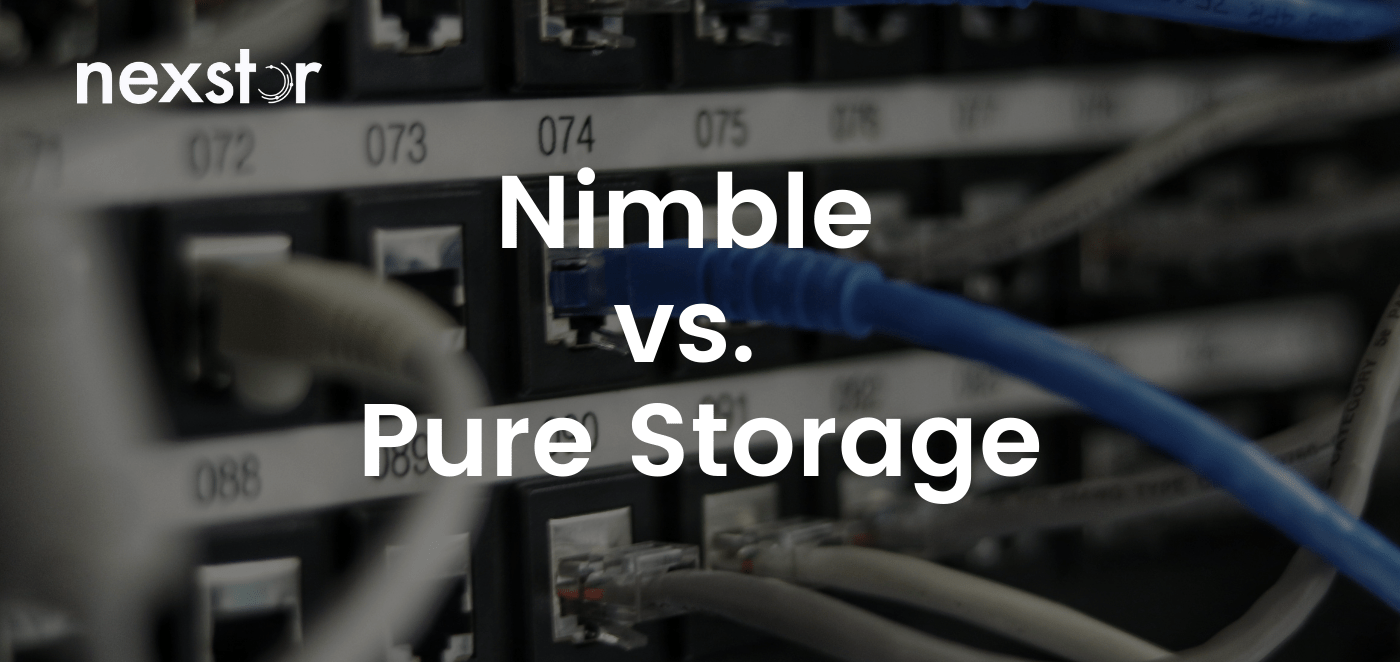Can Hybrid Arrays Still Compete in the All-Flash Data Centre?
The amount of data being created every minute continues to skyrocket. Businesses of all kinds are budgeting for more storage space. In the year 2018 alone, the enterprise storage market grew by 21.3% to a valuation of £10.1 billion.* As the importance of data analytics increases, businesses are looking for more accessible ways to store long-term data. Flash Storage offers instant access to data but is more costly than hard disk drive storage (HDD). Hybrid arrays are a less expensive solution but are also less powerful. This article will summarise and compare the offerings of two of the big players in enterprise storage, Nimble and Pure Storage. The benefits and drawbacks of each will be covered to help you decide what kind of array is right for your business needs. Both companies have attempted to leverage efficiency to offer powerful storage at a lower cost, but they approach the goal from opposite directions. Nimble produces a number of all-flash and hybrid arrays, but are known to excel at hybrid solutions, maximise efficient use of flash to make their hybrid arrays perform as close as possible to all-flash. Pure Storage specialise in all-flash arrays only, and use dedupe and compression to keep the cost per terabyte of their flash down to compete with the lower cost of hybrid arrays.Nimble: Accelerating The Speed of Hybrid Enterprise Storage Arrays
Nimble began as a vendor of hybrid arrays in 2008, and came out with several all-flash Arrays in 2014. By the time they were acquired by HPE in 2016, Nimble had established itself as a dominating force in the hybrid array market. Designed to interface with a number of different hardware and cloud options, Nimble was a leading participant in the reinvention of SAN as a truly unified platform. The acquisition of Nimble by HPE did not bring significant changes to its mission, and has even broadened the storage and backup services which can be integrated with Nimble, augmenting the company’s original goal to create a comprehensive and unified package. One of Nimble’s chief offerings is the easy and affordable scalability of its hybrid arrays. Its scale-out architecture allows for quick expansion of capacity and power. Another major draw for Nimble is its proprietary interface and cloud-based analytics platform — InfoSight. Designed to predict and prevent storage problems before they become disruptions, InfoSight claims to resolve 86% of all issues through optimising storage management and support, and offers a much lauded user interface. InfoSight remains a unique selling point for Nimble, enabling users to troubleshoot latency issues through VMVision, model future requirements such as extra capacity and understand how that will affect cache utilisation etc.Pure Storage: Leveraging the Power of All-Flash
Pure Storage was founded in 2009 and has focused on flash since the beginning. They currently offer a range of all-flash storage arrays. Pure Storage boasts some of the best hardware on the market and supremely high data transfer speeds. Resources are allocated so that each controller operates at 50% utilisation, meaning there is no disruption or performance loss when doing upgrades or maintenance.* The downside to these offerings is the expense. The question becomes whether the increase in performance is worth the increase of cost to your specific needs, or if there is a more cost-effective way to get the nearly same output. Of course, there are other considerations besides the power of the hardware. ‘Purity’ is the name of the ‘software-defined engine’ of Pure Storage’s all-flash arrays. Purity is specifically designed to work with Pure Storage hardware, relying on REST APIs to integrate with third-party hardware, including integration with VMware virtualised platforms. Compared to InfoSight, Purity requires more of its users. It delivers a clean interface but does not possess the same predictive capabilities and hands-off management. It does have the advantage of advanced compression technology: Pure Storage offers 10:1 total efficiency without an impact on performance. Again, this advantage is relevant only to the extent of how performance-intensive your applications are. Many enterprise apps only require 10-15% of data to be stored in flash, so paying more for flash that you do not need is a consideration to be taken seriously.* Pure Storage has invested in advanced compression and deduplication technology specifically to get their cost per terabyte closer to what the hybrid vendors are offering.Pure Storage vs. Nimble: Do You Need All-Flash, All the Time?
With Nimble and Pure Storage each offering a distinct speciality, choosing between them is a question of whether or not you need all-flash all of the time. This question may extend further than the specifics of an individual business’s needs into a broader concern about the future of data storage. To be sure, there are benefits to an all-flash array. Flash is small and uses less power than HDD to maintain, saving you money on electricity as well as reducing the physical and carbon footprint of your data centre. In spite of Pure’s investment in the compression technology needed to make all-flash competitively priced, flash is still so much more expensive in upfront costs that the total cost of ownership of all-flash arrays is higher than their HDD and hybrid counterparts. Per-terabyte, Pure Storage’s hardware remains among the most expensive on the market.* The unequivocal benefit of an all-flash environment is the constant accessibility of the total array at incredible speeds. It is not necessary to tier storage, wait to spin data up from HDD, or engage with unstructured data lakes. All of your data is instantly accessible and siloing data can be avoided. Businesses that process massive amounts of data for use in analytic assessments or simply need constant access to old data sets, an all-flash storage environment might be worth the cost. Pure Storage offers just such abilities with their ‘data hub’ architecture using Purity paired with Flash Blade hardware. Unless an entirely new technology is introduced, flash will remain central to the data centre and enterprise data storage. Nevertheless, investing in the most powerful flash storage isn’t necessarily the best option for your business. Pure Storage’s all-flash arrays may be the most powerful solution, but a hybrid array can deliver most of that power at less cost. Nimble was designed for scalability from the beginning, offering the ability to scale out simply by adding additional shelves. They led the market in their ability to scale up and scale out.* Pure Storage have risen to their competitor’s challenge by introducing greater scalability with their FlashBlade array. Pure Storage arrays are faster, but Nimble arrays use flash more efficiently. For all but the most demanding tasks, CASL allows hybrid Nimble arrays to function as if they are all-flash.Summary: Nimble vs. Pure Storage is a Comparison Between Power and Maximising ROI
Pure Storage offers an all-flash array unmatched in power and data efficiency. Boasting a very high IO throughput and no loss of performance during maintenance, Pure Storage excels at performance-intense applications. Purity is a software management tool that complements Pure Storage’s hardware technology with some of the best dedupe and compression technology available, delivering 10:1 data efficiency. This keeps their cost per usable terabyte down, enabling you to buy less total storage. However, Pure’s all-flash arrays are still far more expensive than a hybrid array such as Nimble’s, and most applications simply don’t require all-flash. Considering the very high cost of flash storage, paying for flash you aren’t using is money down the drain. Nimble’s efficient use of flash and ability to cluster can achieve comparable performance to Pure for most purposes.
Finally, Nimble includes exceptional management software. InfoSight, offers a smooth user experience and advanced performance analytics that provide automatic problem prevention and maintenance. Purity is a functional solution when used within the Pure Storage ecosystem, and has Nimble beat when it comes to dedupe and compression. But, ultimately, cannot compete when it comes to predictive analytics. Considering everything that Nimble’s hybrid arrays have to offer, if your company doesn’t absolutely require all-flash storage, the benefits of Pure are not equivalent to the cost.
However, Pure’s all-flash arrays are still far more expensive than a hybrid array such as Nimble’s, and most applications simply don’t require all-flash. Considering the very high cost of flash storage, paying for flash you aren’t using is money down the drain. Nimble’s efficient use of flash and ability to cluster can achieve comparable performance to Pure for most purposes.
Finally, Nimble includes exceptional management software. InfoSight, offers a smooth user experience and advanced performance analytics that provide automatic problem prevention and maintenance. Purity is a functional solution when used within the Pure Storage ecosystem, and has Nimble beat when it comes to dedupe and compression. But, ultimately, cannot compete when it comes to predictive analytics. Considering everything that Nimble’s hybrid arrays have to offer, if your company doesn’t absolutely require all-flash storage, the benefits of Pure are not equivalent to the cost.
Sources:
*Dell leads the way as enterprise storage market soars *CASL Hybrid Storage Architecture *Pure Storage 101: Ensuring 100% Performance *Nimble Storage vs Pure Storage: A Comparison Snapshot *HPE and Pure Storage all-flash array market shares decline *Nimble Storage vs. Pure Storage: A Battle of All-Flash Arrays

